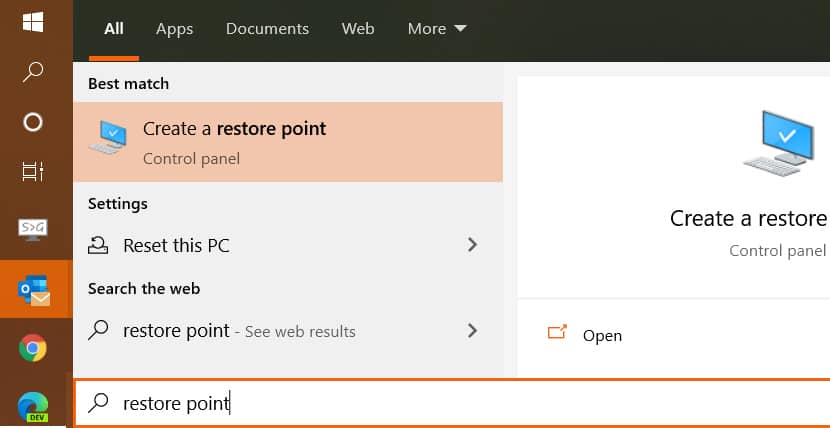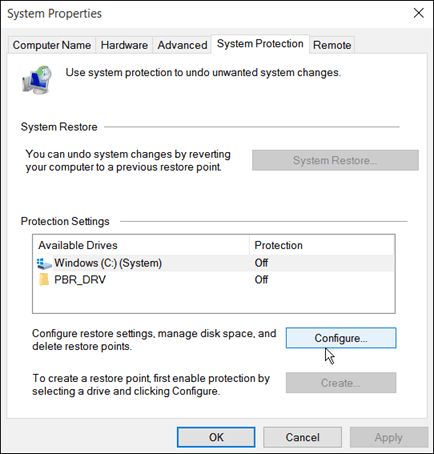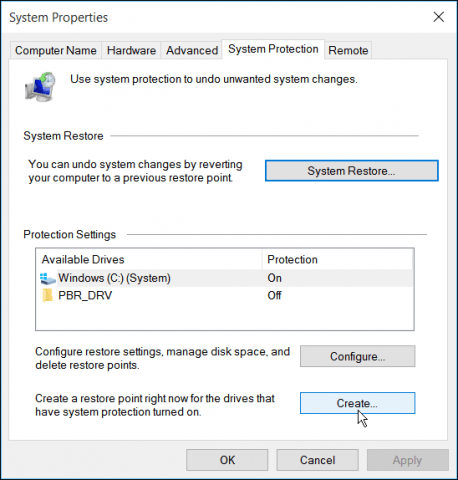Windows 10 Tip: Enable and Create a System Restore Point (Updated)

System Restore is a utility that still exists in Windows 10 and is important to have if something goes awry with your system and you need to get it working again.
Windows 10 has a lot of new features, but many of the old tried, and true system tools still exist. System Restore is one that is still here – and an important one to have if something goes awry with your system and you need to get it working again. I personally use System Restore at least once a year after installing something that goes sideways.
Windows 10 System Restore
In 2020, the easiest way to get to the System Restore / System Protection section is by simply pressing the Windows Key and searching for: restore point. Click Create a restore point when it comes up in the search results.


Once the menu for the System Properties > System Protection menu opens, Click the drive with your System portion (normally C:) and Click Configure button.


Next, you may need to turn on the System Restore utility. It’s usually turned off by default on a computer with Windows pre-installed; in that case, the vendor used its own version of backup software.
From here you can also manage the amount of space it uses. If you have a smaller drive, you might want to turn it down a bit.


Now that you have everything set up click the Create button and follow the onscreen wizard to create a restore point.
The process is the same as it was in Windows 7; you can see a video of how it’s done here.


Update 7/27/2015:
Microsoft is running Windows 10 as a service, and you will be required to install all Windows Updates. It will do this automatically behind the scenes. An update could cause a problem with your hardware drivers, or conflict with software and make Windows 10 crash.
So, at the very least, make sure to enable System Restore, and Windows will automatically create a restore point before installing the updates. Then you will be able to easily recover your system to a point where it worked before the update caused problems.
Also, Microsoft released a utility to hide updates, so they don’t automatically install. For more on that, read our article: Block Automatic Windows 10 Updates and Driver Updates (KB3073930).
12 Comments
Leave a Reply
Leave a Reply







Ziggy
July 15, 2015 at 1:25 am
Many people bag system restore but on numerous occasions it’s got me out of hot water. Great to see Win 10 keeping this feature.
Ziggy
July 15, 2015 at 7:00 am
System restore is often maligned but it has gotten me out of numerous disasters and hence I’m pleased to see it retained in Win 10.
I use Glary utilities to keep these under check and Ccleaner to remove old unwanted system restore points once I’m satisfied that the machine I’m on is behaving.
One thing to note is that unless you give adequate storage for the restore points Windows will delete older restore points in order to create new ones. I’ve allocated 9 gig in order to stop this somewhat annoying feature.
P.S. Great to see all the informative articles of late on the new operating system here at gpost and I can’t wait for the official release to the market version on the 29th July.
Nikki
September 4, 2017 at 4:39 pm
please help me with this restore point? are you there??
josh
November 25, 2015 at 5:06 pm
I’ve enabled system restore on window 10 and manually created a restore point – Thank you. However windows 10 just performed a cumulative update today (which seems to work fine) but after checking system restore, there isn’t any automatic restore point created for the update, only my previous manual creation. Is there another setting I’m missing? I’ve checked around but don’t see anything.
Linda
August 18, 2016 at 4:38 pm
Hey Josh !
Wonder if you wouldn’t mind helping me out? I need to create an earlier restore date than the
system is giving me. Any chance you could walk me through creating a manual restore date?
josh
November 25, 2015 at 5:08 pm
i’ve allocated 10gb so I know that’s not the problem.
Richard
September 3, 2016 at 5:42 am
Please help can’t turn on system protection it’s just grayed out and not giving me a option.
Lynkalin
October 13, 2016 at 1:09 am
Thank you, I have created a restore point. However I don’t see a date and wouldn’t like to use it without knowing how far it backdates to.
I’m probably missing something simple – could someone please tell me where to find the dates?
Pedro
May 26, 2017 at 8:15 am
The System Protection feature will be silently disabled and the restore points deleted if you run low on disk space on the drive. And to make it even worse, there is no obvious notification to the user. I determined this through experimentation and can recreate it. Both Windows10 and Windows7. Nice job Microsoft….
richard
August 10, 2017 at 5:41 am
Contrary to previous Windows systems, in win10 you delete ALL old restore points, including the most recent one. There appears to be no option to save the most recent restore file if you want to clean up your disk. So before removing old resore points, be sure to create a new one.
Karen A. Jones
May 4, 2018 at 4:48 pm
I clicked on all the steps but nothing to happen. Am I suppose to be on a different page.
Andrew Carmichael
October 7, 2021 at 2:09 pm
when I try creating a restore point it creates the current time… I want to manually be able to create a restore point 3 months ago before a downloaded a VIN app on my PC. I have deleted the app but i can no longer use WhatsApp and attach files via wetransfer.
I need help to be able to restore my PC to somewhere around June 30.
Can you help please.